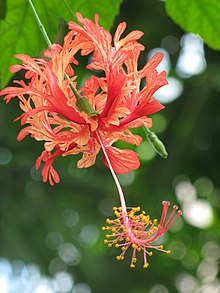Hibiscus schizopetalus
| Hibiscus schizopetalus | |
|---|---|

| |
| Scientific classification | |
| Kingdom: | Plantae |
| Clade: | Tracheophytes |
| Clade: | Angiosperms |
| Clade: | Eudicots |
| Clade: | Rosids |
| Order: | Malvales |
| Family: | Malvaceae |
| Genus: | Hibiscus |
| Species: | H. schizopetalus
|
| Binomial name | |
| Hibiscus schizopetalus | |
Hibiscus schizopetalus is a species of Hibiscus native to tropical eastern Africa in Kenya, Tanzania and Mozambique. Its common names include fringed rosemallow,[1] Japanese lantern, coral hibiscus, and spider hibiscus.
Description
Hibiscus schizopetalus is a shrub growing to 3 metres (9.8 ft) tall.
The red or pink flowers are very distinctive in their frilly, finely divided petals.[2][3] Flowers with finely dissected petal have a range of colours, the most common being the red form (Keena et al., 2002; Ng, 2006). Leaves resemble those of H. rosa-sinensis.
The major anthocyanin found in flowers of H. schizopetalus is cyanidin-3-sambusophoroside (Lowry, 1976). From leaves, two new triterpene esters have been isolated (Jose & Vijayan, 2006).
Uses
Cultivation
Hibiscus schizopetalus is cultivated as an ornamental plant, for use in tropical and subtropical gardens.
Gallery
-
Overall view of Hibiscus schizopetalus shrub.
-
Detail of the end of bloom.
-
Hibiscus schizopetalus flower in Trivandrum, Kerala, India.
-
Hibiscus schizopetalus at the Iguazu Falls, Argentina.
References
- ^ NRCS. "Hibiscus schizopetalus". PLANTS Database. United States Department of Agriculture (USDA). Retrieved 14 May 2015.
- ^ Germplasm Resources Information Network: Hibiscus schizopetalus
- ^ Huxley, A., ed. (1992). New RHS Dictionary of Gardening. Macmillan ISBN 0-333-47494-5.
- Jose, E.A. & Vijayan, K.K. (2006). “New taraxerane esters from Hibiscus schizopetalus leaves”. Indian Journal of Chemistry - Section B Organic and Medicinal Chemistry 45(5): 1328–1331.
- Keena, C., Yanker-Hansen, K., Marcos Capelini, M. (2002). “Marvellous mallows”. http://www.internationalhibiscussociety.org/hiv1n11-1.htm#1.
- Lowry, J.B. (1976). “Floral anthocyanins of some Malesian Hibiscus species”. Phytochemistry 15: 1395–1396.
- Ng, F.S.P. 2006. “Tropical Horticulture and Gardening”. Clearwater Publications, Kuala Lumpur, Malaysia. 361 pp.
External links
 Data related to Hibiscus schizopetalus at Wikispecies
Data related to Hibiscus schizopetalus at Wikispecies




